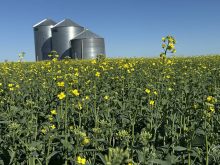Despite incessant rains, hail, tornadoes and other acts of God in 2010, crops in several regions of the Prairies are faring much better than they were at this time last year.For example, the canola crop in central Alberta is in excellent shape compared to 2009, said John Mayko, senior agronomy specialist with the Canola Council of Canada.“As far as last year is concerned, there’s really no comparison,” Mayko said. “In terms of crop establishment … by far (there’s) much better establishment this year, even in the past couple of years.”In early July of 2009, he said canola was barely out of the ground as an extremely cold and dry spring delayed crop development across a large chunk of the Prairies.“Some pockets of central Alberta didn’t receive their first rainfall until the first week in July,” he said. “This year … some of the earlier seeded crops are in 30 percent bloom already.”In central Alberta, which has the majority of the province’s canola acres, farmers are between two extremes. In Alberta’s Peace country, producers need more moisture. In the south, rain has submerged crops, said Lynn Jacobsen, who farms near Enchant, Alta.“A lot of people have said they’re only going to get 50 percent of their crop, even if they did get it seeded,” he said, adding a few crops in the area have endured the excess moisture. “If you got seeded real early … it seems to be better.”Farmers in western Saskatchewan, who were lucky enough to dodge heavy thunderstorms, are also enjoying better success than most. Some crops around Kindersley, Rosetown, Kerrobert and Biggar are thriving this year, said Jeff Simpson, who farms near Ruthilda.“Actually, things look really good,” Simpson said, referring to his 3,200 acres of spring wheat, red lentils and canaryseed. “There are small pockets on the west side of the province that are in good shape.”Simpson said he spoke to a Tisdale, Sask., producer yesterday who managed to seed half of his crop. Most of that is wilting in wet conditions.Near Shoal Lake in western Manitoba, fields that avoided thundershowers look exceptional this year, said Elmer Kaskiw, a crop production adviser with Manitoba Agriculture.“The people that have been able to miss the heavier thunderstorms, they’ve got a really good crop coming on,” he said. ”Especially the crop that was seeded earlier…. There’s lots of areas that are looking quite good.”Across Manitoba, other regions are starting to dry up after a wet May and June, said Andy Nadler, Manitoba Agriculture meteorologist.“I drove through the Red River Valley this weekend and there’s not a lot of sitting water…. It’s nice to see.”
Read Also

VIDEO: Catch up with the Western Producer Markets Desk
The Western Producer Markets Desk provides daily updates on agricultural markets, with recent video commentary including looks into canola, wheat, cattle and feed grains.

















